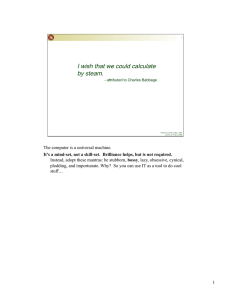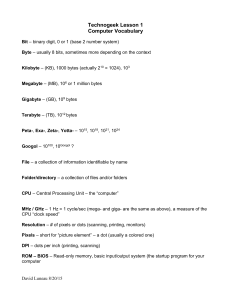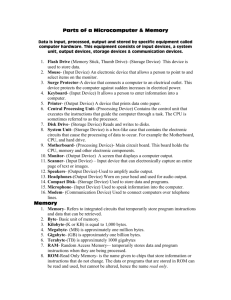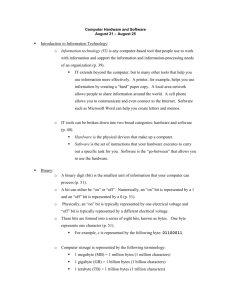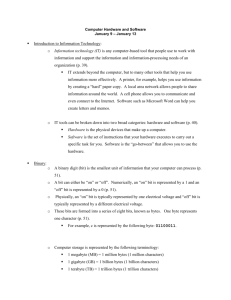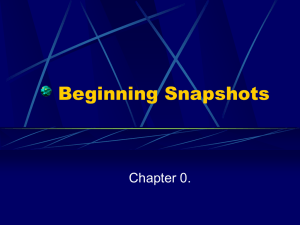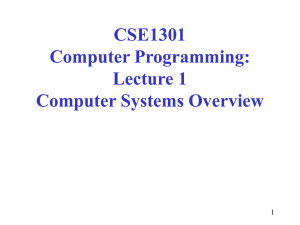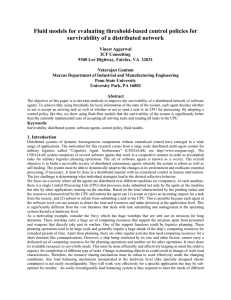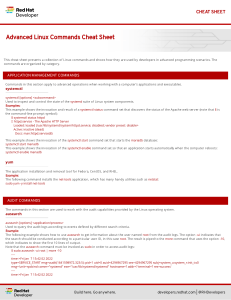The computer is a universal machine. bossy
advertisement
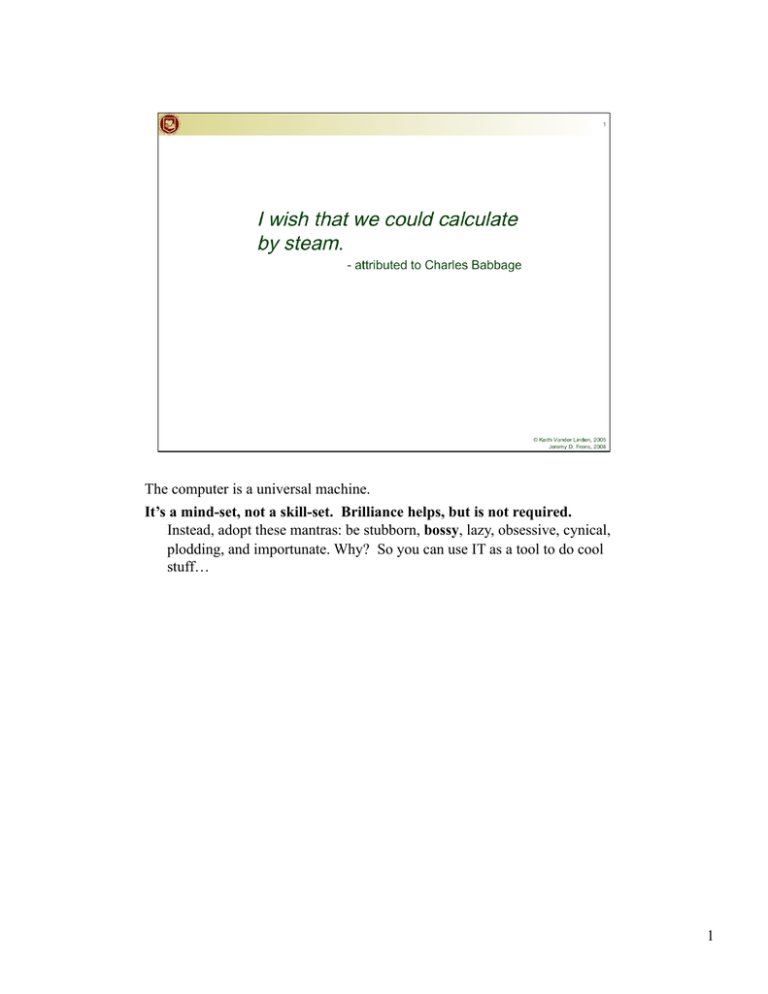
The computer is a universal machine. It’s a mind-set, not a skill-set. Brilliance helps, but is not required. Instead, adopt these mantras: be stubborn, bossy, lazy, obsessive, cynical, plodding, and importunate. Why? So you can use IT as a tool to do cool stuff… 1 Manual computing was very important in the 1800’s (industrial revolution) and into the 1900’s (the world wars) because of the use of mathematical tables in navigation, engineering, etc. The tables were also very hard to produce and filled with errors. A British mathematician named William Shanks spent 28 years of his life calculating Pi to 707 places, finishing in 1873. Soon after his calculations, another mathematician called De Morgan found that Shanks had made an error in the 528th place, after which all his digits were wrong! The 2 definitions show how the view of computing changed around 1940. 3 Babbage died an embittered man, having never convinced anyone of the value of his ideas (apart from Ada and a few others - see the next slide) “recently” links to excellent 4 minute video of Difference Engine No. 2 built after 2000 XXX In the video the machine is much bigger. And the picture is from the British museum? I think I saw it there. 4 She was Countess of Lovelace and Lord Byron’s daughter. She was a supporter and mentor of Babbage. 5 Computers are universal devices, unlike hammers and other artifacts that are designed to do one thing. 11 • CPU/Main Memory - Find info on your machine’s CPU (mouse-right on “My Computer” and choose “Properties”). You should be able to find all the info on your main memory and processor, but our lab may restrict part of that information. • System State - Show the current system use (ctrl-alt-del and choose “Task List”). See what you can find about the current machine state here. • Secondary Storage – Find the size of your hard drive an your other mounted drives. Double-click on “My Computer”. Make particular note of the H: drive. • Peripheral devices – Note the peripheral devices the system has. Note that the printer is mounted remotely and that you now have a print quota at Calvin. • Network – Check the network connection speed (using the task manager opened above). • Software – Check out the OS (using “My Computer” – “Properties”) and the application programs as time allows. 12 The computer’s speed/efficiency is based on these characteristics. To speed things up, increase the number of cores or the clock speed. Least control over word size. The Central Processing Unit (CPU) - You can find information on your MS Windows system processor in the system properties browser (start this tool by either clicking mouse-right on the "My Computer" icon on the desktop and choosing "Properties", or by choosing "Start"-"Settings"-"Control Panel"-"System"). 14 Usually RAM 15 16 17 Bit - A single 0 or 1 Byte - 8 bits: enough to store one character Kilobyte (KB) – 1024 (2^10) characters: a paragraph of text Megabyte (MB) - ~1 million (2^20) bytes: a book or a minute of mp3 audio Gigabyte (GB) - ~1 billion (2^30) bytes: 16 hours mp3 audio, 20 minutes of DVD video Terabyte (TB) - ~1 trillion (2^40) bytes: all the text in Calvin’s library, or 150 DVD movies 18 19 Impress upon them the importance of (psychotically) backing things up. Your H: drive in the windows lab is a network drive that is backed up by CIT. So is the Knightvision server. 22 23 Just summarize the basic types of software, without visiting the slides: OS - manages the hardware/software of the computer, e.g., MacOS, Windows, Linux Applications - support basic user tasks, e.g., Word, Excel, Dreamweaver, Powerpoint 25 Algorithms are like recipes. We’ll see them used in a programming language in this week’s lab. print “Enter your name” name = get_input() while name == “”: print “I mean it!” name = get_input() if name == “Vic”: print “Hey, Vic! Hi!” 26 e.g., C++, Java, VB.net Most of these students won’t do much programming, so they probably won’t need PL support on their machines. 27 28 Programs multi-tasking (show the processes and the applications in the task manager) Memory Loads files from disk when needed (show memory use in task manager) Files on secondary store keeps track of files on disk (discuss the A:, C: and F: drives in windows explorer) Peripherals I/O devices “talks” to all the external devices Network connections maintains the network connection (if any) (show network connection in task manager) 29 30 There is some question as to whether this trend will continue and if it will ever hit a “wall”. See Kurzweil. Moving to multi-core changes speed-up claim. Note the log scale on the left!!!!! Exponential growth!! 32 Key problems: Computer technology costs money that people don’t have. Computer literacy costs money. IT is decidedly western in structure and support (e.g., the worldwide-web is not really world-wide). 33
